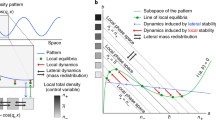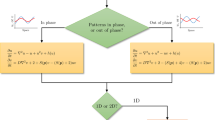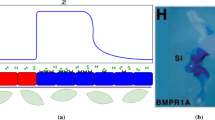Abstract
Pattern formation in many biological systems takes place during growth of the underlying domain. We study a specific example of a reaction–diffusion (Turing) model in which peak splitting, driven by domain growth, generates a sequence of patterns. We have previously shown that the pattern sequences which are presented when the domain growth rate is sufficiently rapid exhibit a mode-doubling phenomenon. Such pattern sequences afford reliable selection of certain final patterns, thus addressing the robustness problem inherent of the Turing mechanism. At slower domain growth rates this regular mode doubling breaks down in the presence of small perturbations to the dynamics. In this paper we examine the breaking down of the mode doubling sequence and consider the implications of this behaviour in increasing the range of reliably selectable final patterns.
Similar content being viewed by others
References
Bard, J., Lauder, I., 1974. How well does Turing's theory of morphogenesis work? J. Theor. Biol. 45, 501–531
Crampin, E.J., 2000. Reaction–diffusion patterns on growing domains. DPhil thesis, University of Oxford, UK.
Crampin, E.J., Gaffney, E.A., Maini, P.K., 1999. Reaction and diffusion on growing domains: Scenarios for robust pattern formation. Bull. Math. Biol. 61(6), 1093–1120.
Crampin, E.J., Gaffney, E.A., Maini, P.K., 2002. Mode doubling and tripling in reaction–diffusion patterns on growing domains: A piecewise linear model. J. Math. Biol. 44(2), 107–128.
DeKepper, D., Castets, V., Dulos, E., Boissonade, J., 1991. Turing-type chemical patterns in the chlorite–iodide–malonic acid reaction. Physica D 61, 161–169.
Dillon, R., Maini, P.K., Othmer, H.G., 1994. Pattern formation in generalised Turing systems I: Steady state patterns in systems with mixed boundary conditions. J. Math. Biol. 32, 345–393.
Doedel, E.J., Paffenroth, R.C., Champneys, A.R., Fairgrieve, T.F., Kuznetsov, Y.A., Sandstede, B., Wang X., 1997. AUTO 2000: Continuation and Bifurcation Software for Ordinary Differential Equations (with HomCont). Technical Report, Caltech, February 2001.
Hayes, C., Brown, J.M., Lyon, M.F., Morriss-Kay, G.M., 1998. Sonic hedgehog is not required for polarising activity in the Doublefoot mutant mouse limb bud. Development 125, 351–357.
Iron, D., Wei, J., Winter, M., 2004. Stability analysis of Turing patterns generated by the Schnakenberg Model. J. Math. Biol. 49(4), 358–390
Keller, E.F., Segel, L.A., 1970. The initiation of slime mold aggregation viewed as an instability. J. theor. Biol. 26, 399–415.
Kolokolnikov, T., Ward, M.J., Wei. J., 2005. The existence and stability of spike equilibria in the one-dimensional Gray–Scott model on a finite domain. Appl. Math. Lett. 18(8), 951–956.
Kondo, S., Asai, R., 1995. A reaction–diffusion wave on the skin of the marine angelfish Pomacanthus. Nature 376, 765–768
Meinhardt, H., 1995. The Algorithmic Beauty of Sea Shells. Springer, Heidelberg.
Murray, J.D., 2003. Mathematical Biology. 3rd edition in 2 volumes: Mathematical Biology: II. Spatial Models and Biomedical Applications, Springer, New York.
Ouyang, Q., Swinney, H.L., 1991. Transition from a uniform state to hexagonal and striped Turing patterns. Nature 353(6336), 610–612.
Segel, L.A., Jackson, J.L., 1972. Dissipative structure: An explanation and an ecological example. J. Theor. Biol. 37, 545–559.
Turing, A.M., 1952. The chemical basis of morphogenesis. Phil. Trans. R. Soc. Lond. B 237, 37–72.
Yoon, H.-S., Golden, J.W., 1998. Heterocyst pattern formation controlled by a diffusible peptide. Science 282, 935–938.
Author information
Authors and Affiliations
Rights and permissions
About this article
Cite this article
Barrass, I., Crampin, E.J. & Maini, P.K. Mode Transitions in a Model Reaction–Diffusion System Driven by Domain Growth and Noise. Bull. Math. Biol. 68, 981–995 (2006). https://doi.org/10.1007/s11538-006-9106-8
Received:
Accepted:
Published:
Issue Date:
DOI: https://doi.org/10.1007/s11538-006-9106-8




